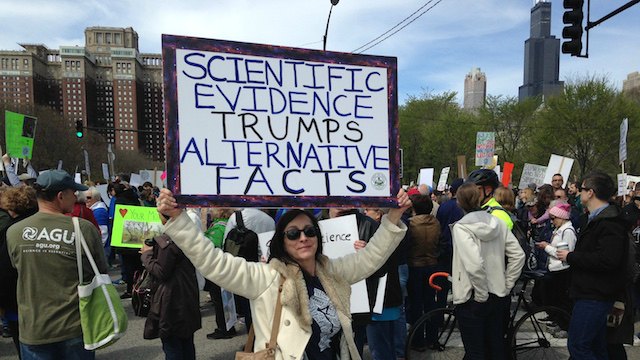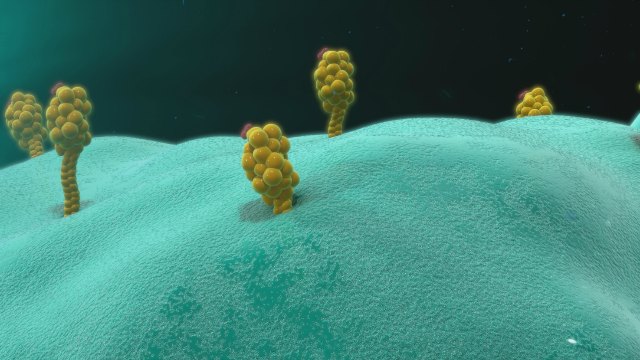 Peggy Mikros, a caterer, at the March for Science in ChicagoKERRY GRENSThe past 12 months have seen no shortage of science scandals, policy upheaval, and publishing turmoil (so we gave them their own dedicated end-of-year summaries). Yet the show of solidarity within the scientific community this year could warm the heart of even the sourest Grinch. Scientists rallied together by the tens of thousands to advocate for evidence-based policymaking during the March for Science; they opened up their labs to researchers affected by hurricanes and travel bans; and they protested against sexual harassment by colleagues and inaction by institutions.
Peggy Mikros, a caterer, at the March for Science in ChicagoKERRY GRENSThe past 12 months have seen no shortage of science scandals, policy upheaval, and publishing turmoil (so we gave them their own dedicated end-of-year summaries). Yet the show of solidarity within the scientific community this year could warm the heart of even the sourest Grinch. Scientists rallied together by the tens of thousands to advocate for evidence-based policymaking during the March for Science; they opened up their labs to researchers affected by hurricanes and travel bans; and they protested against sexual harassment by colleagues and inaction by institutions.
Here are stories that have made 2017 a year to remember.
Marching for science
From the rainy US capital to sunny Chicago to brisk Berlin, scientists and their supporters took to the streets across the globe for the largest science advocacy event in...
For many researchers, it was their first time advocating for their field. “I’ve never protested before, ever,” Karl Klose, a microbiologist at the University of Texas, San Antonio, told The Scientist at the march in Washington, D.C. But he was motivated to do so after Trump’s proposed budget included major slashes to funding for the National Institutes of Health. “It was kind of like a gut punch to me,” he said.
Hurricanes crash through labs
 The storm blew part of the roof off of the Marine Science Institute's headquarters building. THE UNIVERSITY OF TEXAS MARINE SCIENCE INSTITUTE
The storm blew part of the roof off of the Marine Science Institute's headquarters building. THE UNIVERSITY OF TEXAS MARINE SCIENCE INSTITUTE
Late August marked the start of devastating hurricanes that ripped across the Gulf of Mexico and the Caribbean, leaving entire cities underwater. Labs braced for impact as best they could, but some nonetheless suffered immense damage, whether in Texas, Florida, or Puerto Rico. In other cases, past flooding experiences, particularly, 2001’s Tropical Storm Allison in Houston, led to the development of flood walls and other preventive measures that saved some academic labs from water damage.
See “How Animals and Plants Weather Hurricanes”
Gene-edited embryos
 ISTOCK, UGURHAN
ISTOCK, UGURHAN
It wasn’t a first in 2017, but the genetic alteration of human embryos using CRISPR made some considerable advances this year. Most notably was the correction of a disease-causing gene in embryos conducted by researchers in the U.S.
The achievement was hailed as impressive—Harvard University’s George Church told The Scientist at the time that it “makes previous work look pretty amateurish”—but Church and others later found ways to pick apart some of the study’s conclusions.
In September, the group in China that was the first to announce it had edited genes in human embryos reported successfully correcting a disease-causing point mutation using base editing. That same month, U.K.-based researchers used CRISPR to knock out a gene in human embryos, but they weren’t seeking to cure a disease; rather, they were exploring the basic biology of embryonic development—a key difference for ethical considerations.
See “New Techniques Detail Embryos’ First Hours and Days”
First patient receives gene-editing therapy
 WIKIMEDIA, THOMAS SPLETTSTOESSER
WIKIMEDIA, THOMAS SPLETTSTOESSER
It’s not just embryos getting their aberrant genes corrected. The first human to have a genetic disease repaired by gene editing—in this case, zinc finger nucleases did the job—was a man in Oakland, California, suffering from Hunter syndrome. The nucleases were designed to introduce a functional copy of an enzyme into the patient’s liver.
See “First In Vivo Genome Editing to be Tested in New Clinical Trial”
CRISPR is not far behind in entering clinical trials. A company announced this month it has applied for approval in Europe to test its therapy for sickle cell disease and β thalassemia in patients.
Boy receives transgenic skin
 CMR UNIMORE
CMR UNIMORE
Genetic engineering made a dramatic rescue this year, saving the life of a now 9-year-old boy, a Syrian refugee living in Germany, with a devastating skin disease. Most of his skin had turned to painful blisters, and his chances of survival were slipping away. That’s when Michele De Luca of the University of Modena and Reggio Emilia in Italy and colleagues took a small piece of skin from the child, used a viral vector to insert a healthy copy of the gene that was malfunctioning, and grew sheets of new skin, which were transplanted onto the boy in 2015. Today he is alive and well, playing soccer and going to school.
CRISPR patent dispute continues
 © BRYAN SATALINO
© BRYAN SATALINO
In February, the US Patent and Trademark Office (USPTO) ruled on a dispute between two groups of CRISPR developers—one at the Broad Institute of MIT and Harvard University and another based at the University of California, Berkeley. Both had submitted patents for the gene-editing technology, and when an all-encompassing patent was awarded to the Broad team, the University of California team had appealed. The much-anticipated February decision upheld the Broad’s patent.
The saga has since continued, with the University of California challenging the USPTO’s conclusion in the US Court of Appeals for the Federal Circuit in Washington, D.C. Interestingly, shortly after the USPTO’s decision, the European Patent Office awarded the University of California group a broad patent for CRISPR.
See “Flux and Uncertainty in the CRISPR Patent Landscape”
CAR T approvals
 ISTOCK, 7ACTIVESTUDIO
ISTOCK, 7ACTIVESTUDIO
In August, the US Food and Drug Administration (FDA) approved the first treatment based on chimeric antigen receptor (CAR) T-cell immunotherapy. “We’re entering a new frontier in medical innovation with the ability to reprogram a patient’s own cells to attack a deadly cancer,” FDA Commissioner Scott Gottlieb said at the time. The therapy, costing hundreds of thousands of dollars, is to be used for patients under 25 years of age with B-cell acute lymphoblastic leukemia.
A second CAR T-cell therapy approval came in October, for large B-cell lymphomas. Both are approved for patients who have failed to respond to other cancer treatments.
See “Making CAR T-Cell Therapy Safer”
Interested in reading more?





